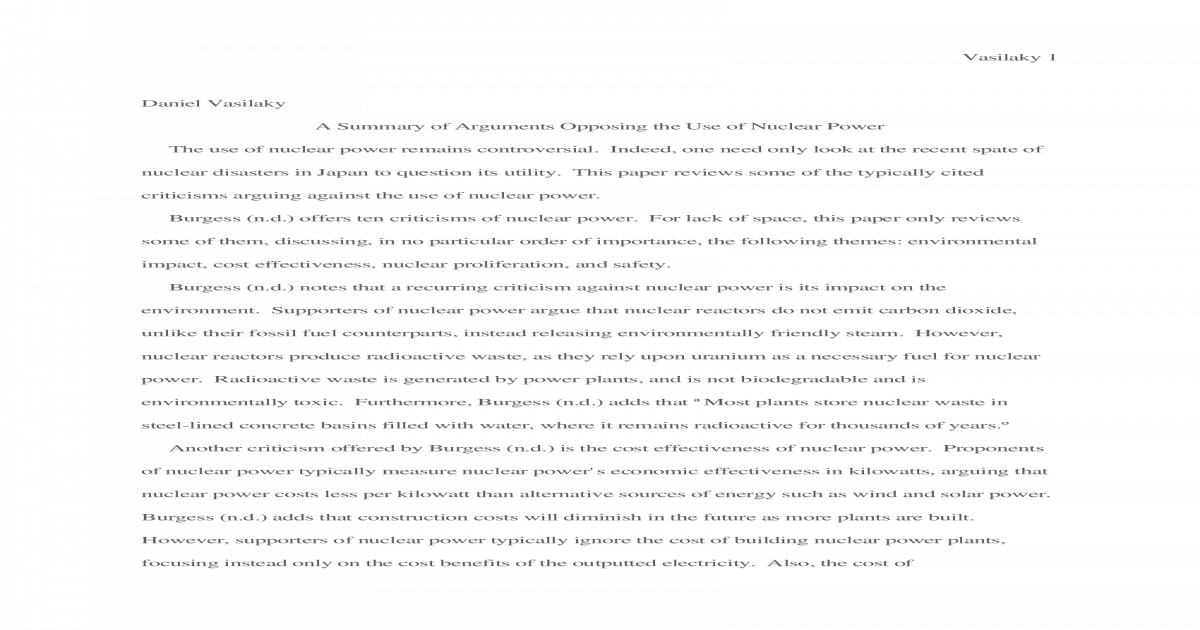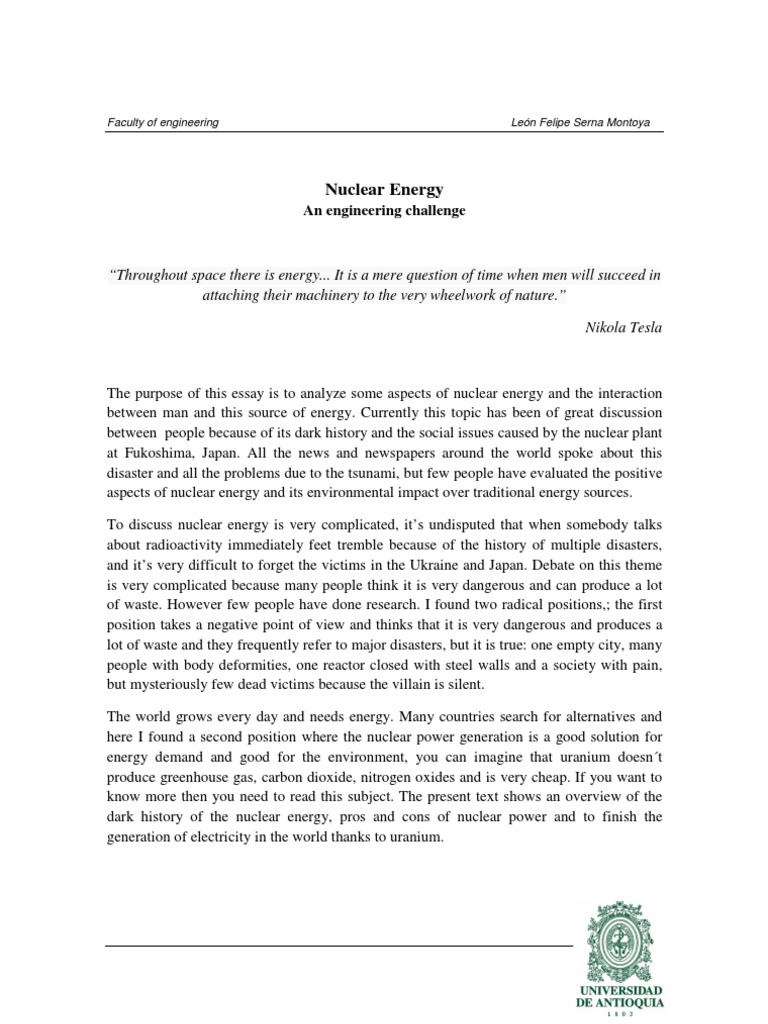
Nuclear energy is a mode of generating heat through the fission of atoms. Entirely all power plants create electricity by converting heat through the steam. Nuclear energy is a key form of created energy when an atom is split with a proton Thesis statement: Although nuclear energy has been proposed as a solution for our energy requirements it is not reliable because of issues regarding safety, nuclear waste storage. It is possible in a medium-long period of time to replace it with renewable energies. Nuclear energy is one of the lastest sources of energy discovered by humanity previously stated, nuclear energy is able to decrease emissions, but also would be able to meet the energy demands. Many politicians and scientists agree. According to Moore (), “Prominent Author: Hannah G. Hilliard
An Investment Thesis for Nuclear Energy - MarketPsycles
This effort, pioneered by Robert Oppenheimer, set the stage for weaponizing nuclear energy. The world now fears the radical power held by nuclear owing to the tragedy of Hiroshima and Nagasaki. Fast forward almost 75 years; nuclear energy is viewed as a dangerous fuel to create armageddon-esque weapons. The earthquake cut off the power supply to the component of the nuclear system that was removing decaying heat from the reactor. This event caused no direct deaths, and the fatalities caused by radiation are near impossible to attribute.
In order to understand the danger posed by nuclear energy, you need to understand how nuclear works. A reactor is made up of zirconium rods that have triuranium octoxide U3O8 pellets inside of them. Energy is produced through the process of fission. Fission, in this context, occurs when the nucleus of the uranium atom is spliced into two or more nuclei. Neutrons energy created by fission are transferred through the zirconium rods toward the electricity-generating turbine.
So, if these zirconium rods incur excess heat, they react with the water and cause a hydrogen explosion. Removing excess heat is arguably the most important part of the process, and this resulted in 3 nuclear reactor meltdown in Fukushima.
Private sector energy generators across the world are unable to experiment much with nuclear given regulatory restraints. The Fukushima disaster resulted in renewed negativity towards nuclear energy, thesis for nuclear energy. The economics of uranium and nuclear are quite peculiar. In order to have uranium processed and ready for use in nuclear generation, it has to be procured and processed at least a few months to a year in advance.
Cameco data shows us that the long thesis for nuclear energy market has contracted and remained stable, while the spot market has seen a healthy bump over the last few years. Fukushima-induced demand reduction is very easy to spot, thesis for nuclear energy. Kazhakstan increased their share of uranium supply from 10 percent to 40 percent over the last 10 years.
They continued to expand supply in a time when demand was dwindling, thesis for nuclear energy. This excess supply resulted in prices crashing and many existing uranium miners shutting down certain operations.
Some countries consider uranium imports to be an issue related to national security. In fact, uranium producers in the United States asked the government to investigate whether uranium imports should be classified in this manner, thesis for nuclear energy.
They wanted the United States to impose a quota on import of uranium to incentivize electricity generators to source their uranium domestically. Nuclear is the most expensive type of electricity capacity to set up from a fixed cost perspective. Recent escalation thesis for nuclear energy this cost has created a lot more negative sentiment around the industry as a whole. Generating nuclear energy requires top-notch safety standards and qualified scientists and labour.
This brings the overall variable costs above other sources of energy. Looking at cost in absolute numbers is quite grim. It makes nuclear look an expensive outlier to otherwise cheap electricity generation. But, looking at energy sources in terms of how much real energy can be amassed from it paints a thesis for nuclear energy more descriptive picture. As you can see, uranium is sheer orders of magnitude more efficient than any fuel currently being used. Yes, that data thesis for nuclear energy correct — one kilogram of uranium can producemegajoules of energy.
Heat decay from nuclear reactors is the most critical process for making nuclear energy safe. United States, France, Russia, and China — four countries heavily dependent on nuclear energy — are designing sodium fueled nuclear reactors SFRs.
In the traditional process, zirconium rods filled with uranium pellets are submerged in water. Using SFR, these rods are instead submerged in molten sodium. This reduces the amount of decayed heat that is produced without meaningfully reducing energy generation.
It also makes it easier to stop fission if necessary, thesis for nuclear energy. All of this aside, the biggest benefit is that even if excess heat is produced, there is no hydrogen thesis for nuclear energy as there is no water to react with the zirconium.
Sodium transfers heat created by fission just as well as water does. Combining SFRs with thorium instead of uranium further increases safety measures, thesis for nuclear energy. Radiation waste created by thorium is much less than that of uranium, meaning it causes less contamination and reduces thesis for nuclear energy need for disposal. Uranium is fissile, meaning it can undergo fission by itself.
Thorium is fertile, meaning it can undergo fission after absorbing a neutron. Simply put, thorium can turned into a fissionable fuel through a fairly simple process read more about this here. Believe it or not, nuclear will be a vital tool in tackling climate change and ushering in a new era of sustainable electricity generation.
Emissions from nuclear are on par with biomass, solar, and wind energy on an intensity basis. This means emission per unit of production is low because of how efficient uranium and thorium are.
There is a dire requirement to reform our ways and reduce dependence on fossil fuels such as coal, oil, diesel, and other petroleum products, thesis for nuclear energy. Renewables are being propelled as the saviour, thesis for nuclear energy, but — as explained above — nuclear can go a long way in helping the world meet its energy needs at minimal cost.
Solar and wind have incredibly low absolute emission levels, but energy generation is quite poor — especially in solar. A photovoltaic panel solar panel is governed by the Shockley-Queisser limit.
Without going into much detail, this theory suggests that solar panels can only absorb a maximum of 20 percent of the total energy thrown at it. So if the sun emits units of energy at a panel, it can — at most — absorb 20 to 30 units of it. Another major problem with wind and solar is storage. When the sun is out, thesis for nuclear energy, or when the wind is blowing, electricity can be generated and sent across the grid, thesis for nuclear energy.
But storing this energy is still very inefficient. Additionally, transmission losses in the nuclear cycle are far lower than solar and wind.
In an ideal mix of sustainable power, solar could be used in the day time, wind could be used in tandem to solar, and nuclear can be used to meet any deficits in electricity needs. Global energy demand grew by 4 percent inand there is no major reason to expect this to meaningfully change in the near future. However, with a global push for electric vehicles, there will be additional demand for electricity relative to fossil fuels. And if oil is used to generate the electricity that powers our electric vehicles, we might as well power our vehicles directly with oil-based derivatives like petroleum and diesel.
For electric vehicles to make the impact we want them to make, they have to consume sustainably sourced electricity. As with anything, there a bunch of negatives while making the case for nuclear energy.
In this particular case, the negatives are far, thesis for nuclear energy, far stronger than the benefits due to social and political risks. Here is a brief outline of the negatives with regards to nuclear:. Nuclear will help achieve sustainable energy without majorly affecting thesis for nuclear energy. In fact, thesis for nuclear energy, nuclear can be cheaper than solar and wind even without the government subsidies given to renewables.
Increased reliance on nuclear can lower global emissions to a large extent. The stigma around nuclear is still shrouded by a thick barrier.
It is understandable that many people do not want energy trends to go in the direction of a resource that can be weaponized and used to destroy humanity. However, nuclear still is our best bet at making electricity cheap and clean without hindering production. India, China, Russia, and other Asian countries are expanding their foray into nuclear energy. Other countries like the United Thesis for nuclear energy and France, which have relatively high nuclear dependence, are shifting towards renewables and trying to reduce their reliance on nuclear power.
All in all, there is huge scope for growth, but there are also massive headwinds plaguing the industry. Prices are suppressed, and stocks like Cameco, Energy Fuels Inc, and Next Era Energy have taken a severe beating over the last few years.
The risk in absolute terms is very high, but the reward is exponentially higher than risk. So even though this is a risky play, it will be incredibly rewarding to investors in this sector if this bull thesis plays out, thesis for nuclear energy. The sole basis of this is that nuclear can help achieve sustainable energy targets, albeit at a cost.
Any innovation that is safer and efficient is obviously preferable to nuclear considering the severity of the negative effect. I am not an expert on energy. Source: World Nuclear Organization Neutrons energy created by fission are transferred through the zirconium rods toward the electricity-generating turbine. State of Nuclear Economics Private sector energy generators across the world are unable to experiment much with nuclear given regulatory restraints, thesis for nuclear energy.
Source: Cameco Market Data Cameco data shows us that the long term market has contracted and remained stable, while the spot market has seen a healthy bump over the last few years. Source: World Nuclear Organization Some countries consider uranium imports to be an issue related to national security. Cost Associated with Thesis for nuclear energy Production Nuclear is the most expensive type of electricity capacity to set up from a fixed cost perspective.
Data source: U. Energy Information Administration Looking at cost in absolute numbers is quite grim. Data source: World Nuclear Organization As you can see, uranium is sheer orders of magnitude more efficient than any fuel currently being used. The Bull Thesis Heat decay from nuclear reactors is the most critical process for making nuclear energy safe. Climate Change and the Need for Sustainable Energy Believe it or not, nuclear will be a vital tool in tackling climate change and ushering in a new era of sustainable electricity generation.
Sourcing Clean Electricity Without Compromising Efficiency Another major problem with wind and solar is storage. Negatives and Potential Headwinds As with anything, there a bunch of negatives while making the case for nuclear energy.
Here is a brief outline of the negatives with regards to nuclear: Regulatory headwinds owing to the danger posed by nuclear reactors. Summing it Up Nuclear will help achieve sustainable energy without majorly affecting cost. Read next Interest Rates on DeFi: Eliminating Arbitrage with Market Efficiency.
Nuclear Energy Research (Thesis)
, time: 1:34
Oct 19, · The Bull Thesis. Heat decay from nuclear reactors is the most critical process for making nuclear energy safe. Considering this, it’s quite obvious the efforts going into nuclear innovation are trying to find a way to improve this process – and improve this they blogger.comted Reading Time: 10 mins previously stated, nuclear energy is able to decrease emissions, but also would be able to meet the energy demands. Many politicians and scientists agree. According to Moore (), “Prominent Author: Hannah G. Hilliard The objective of this thesis is to consider the role of nuclear power in the future energy system. Nuclear power is a low carbon energy technology because it produces virtually no air pollutants during operation. In this respect, nuclear power is suitable for a carbon free energy system. In this master's thesis, the basic characteristics of nuclear power are presented and compared to fossil fuelled and renewable

No comments:
Post a Comment